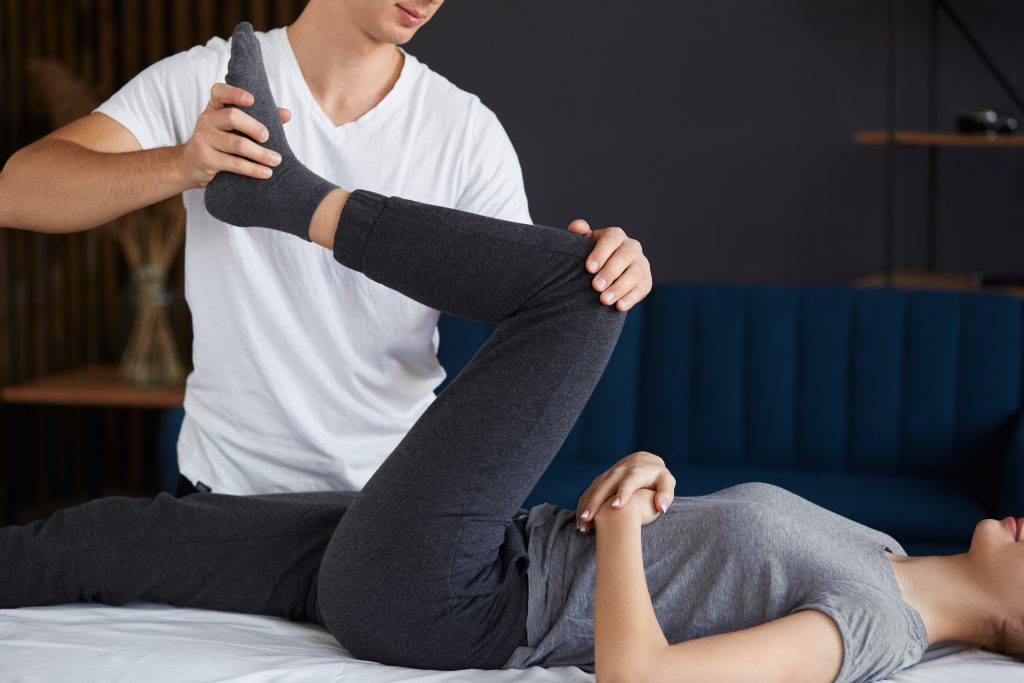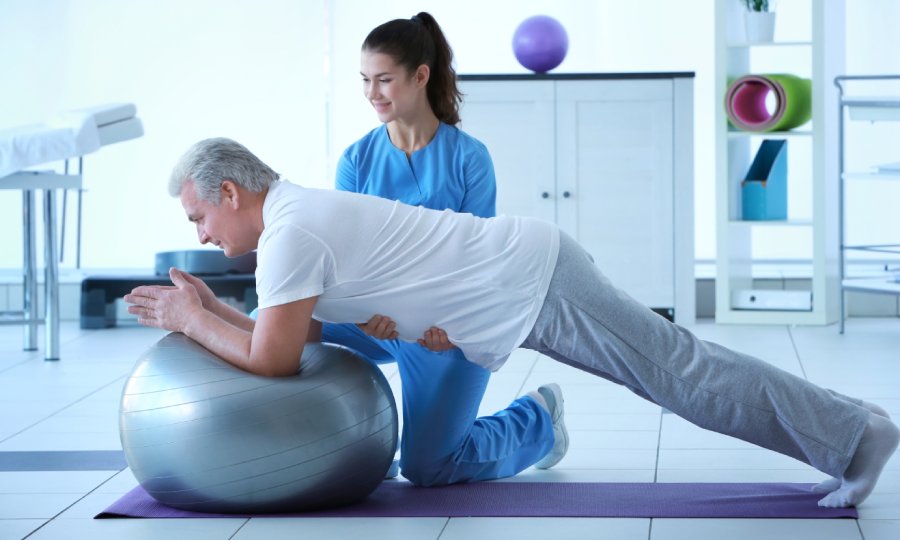Perhaps your loved ones or you yourself have experienced a femoral neck fracture. This is one of the most complex and serious injuries requiring long-term recovery. The rehabilitation process may raise many questions and concerns, but we are here to facilitate this transition and help you or your loved one return to a fulfilling life. After reading this article, you will learn about the process of treatment and recovery, recommendations for physiotherapy, nutrition, psychological support, as well as how to return adequately to work and everyday life.
Femoral Neck Fracture

What is a femoral neck fracture?
A femoral neck fracture is a severe traumatic injury that most often occurs in the elderly as a result of a fall. It involves a breach in the integrity of the femoral neck, located between the body and the head of the femur. Treatment of such an injury often involves surgical intervention, and an important part of recovery is a long-term rehabilitation.
Causes and Risk Factors of Femoral Neck Fractures
The main causes of femoral neck fractures are falls, especially among the elderly. Risk factors include aging, osteoporosis (thinning of bone tissue), chronic diseases such as diabetes, and certain medications. In addition, the risk increases in individuals who have balance and coordination problems.
Femoral Neck Fracture Treatment: Surgery and Procedures
The treatment of a femoral neck fracture usually requires surgery. There are different types of surgeries, the selection of which depends on the patient’s age, general health status, and type of fracture. One of the most common surgeries is hip arthroplasty, in which the damaged joint is replaced with an artificial one.

What to Expect in the Hospital After Surgery
After surgery, patients usually stay in the hospital for several days to a week. The first days after surgery are important for pain control, prevention of complications such as thrombosis or infection, and the start of mobilization under the supervision of medical staff.
Stages of Recovery and Rehabilitation Planning
After discharge from the hospital, the long process of rehabilitation begins. Recovery usually occurs in several stages, which include transitioning from crutches or walkers to full weight-bearing, exercises to restore strength and mobility, and ultimately, returning to normal household and work duties.
Importance of Early Mobilization and Exercise
Early mobilization is a crucial factor for successful recovery. Patients typically begin walking the day after surgery using crutches or walkers. This helps prevent complications such as thrombosis and promotes rapid recovery.
Physiotherapy and Exercises

Importance of Physiotherapy in Rehabilitation
Physiotherapy plays a key role in the recovery process after a femoral neck fracture. It helps restore the functionality and strength of the leg, improve balance and coordination, and return to normal life.
Types of Exercises and Their Importance for Recovery
Exercises after a femoral neck fracture include flexibility, strength, balance, and walking exercises. All of them help improve mobility, prevent muscle mass loss, and contribute to a quick return to normal life.
Planning and Increasing Exercise Intensity
It’s important to remember that the increase in exercise intensity should be gradual and individual. This means that you should start with a small number of low-load exercises, gradually increasing their number and complexity.
Key Exercises for Rehabilitation After a Femoral Neck Fracture
After a femoral neck fracture, it’s important to start doing exercises as soon as possible to restore strength, flexibility, and balance. However, each case is unique, and the exercises should be tailored to the specific needs of the patient. Always consult with a doctor or physiotherapist before starting a new exercise program.
- Thigh muscle compression exercise: The purpose of this exercise is to strengthen the muscles of the front of the thigh. Sitting or lying down, squeeze the thigh muscles, trying to pull the knee towards the floor. Hold the squeeze for a count of five, then relax.
- Leg lift exercise: This exercise helps strengthen the thigh and gluteal muscles. Lying on your back, raise your straight leg about 30 cm off the floor. Hold for a count of five, then slowly lower your leg.
- Foot lift exercise: This exercise helps improve circulation and prevent swelling. Lying on your back, slowly raise and lower your feet.
- Foot rotation exercise: This exercise helps improve flexibility and circulation in the foot. Sitting or lying down, rotate your foot in both directions.
- Torso lift exercise: This exercise helps strengthen the gluteal muscles and the lower back. Lying on your back, bend your knees, feet on the floor. Slowly lift your torso until your body forms a straight line from your knees to your shoulders.
- Hamstring stretch exercise: This exercise helps improve the flexibility of the hamstrings. Sitting, extend one leg in front of you, bend the other one at the knee. Lean forward, trying to reach your hands to the extended leg.
Remember, each exercise should be done slowly and carefully, avoiding pain. If you experience pain during an exercise, immediately stop it and consult a doctor.
Video: “Rehabilitation After a Femoral Neck Fracture”
Exercises for the pelvic girdle and hip joint. Set No.2 is aimed at strengthening the muscles
For additional information about the recovery process after a femoral neck fracture, you can watch a video demonstrating exercises and rehabilitation recommendations.
Proper Nutrition and Lifestyle

Role of Nutrition in the Recovery Process
Proper nutrition is an important factor in recovery after a fracture. Consumption of enough sufficient protein, vitamins, minerals, especially calcium and vitamin D, is important for fracture healing and overall health.
Importance of Balanced Nutrition for Recovery after a Femoral Neck Fracture
- Proteins: Protein intake is critically important for muscle and tissue recovery after a fracture. The main sources of protein include meat, fish, eggs, dairy products, legumes, quinoa, and some nuts and seeds.
- Calcium and Vitamin D: These two important nutrients play a key role in bone healing. Sources of calcium include dairy products, broccoli, turnip greens, as well as fortified cereals and juices. Vitamin D can be obtained from fatty fish, eggs, dairy products, and also from sunlight.
- Magnesium: Magnesium helps the body effectively use calcium and vitamin D. Magnesium-rich products include green leafy vegetables, nuts, seeds, legumes, and grains.
- Antioxidants: Consuming products rich in antioxidants can help reduce inflammation and facilitate the healing process. Vegetables, fruits, nuts and seeds, green tea, and dark chocolate are all excellent sources of antioxidants.
- Omega-3 fatty acids: They can help reduce inflammation and facilitate healing. It can be found in fatty fish, nuts, and flax seeds.
- B Vitamins: They support the health of the nervous system and help the body use energy from food. It can be found in whole grain products, legumes, nuts and seeds, meat, and fish.
- Seaweeds: Help to maintain bone and joint health. They can be found in some types of fish, seaweeds, and fortified products.
Make sure that your rations contain a variety of these food products to accelerate the body’s recovery after a femoral neck.
Importance of Rest and Sleep
Rest and sleep also play a key role in the recovery process. They help the body regain strength, reduce stress levels, and contribute to overall well-being.
Preventing Recurrent Fractures: Lifestyle Recommendations
To prevent recurrent fractures, it’s important to maintain an active lifestyle, eat adequately, avoid falls, strengthen muscles, and take good care of your health.
Psychological Support in Rehabilitation

Importance of Psychological Support in the Recovery Process
Rehabilitation after a femoral neck is not only a physical process but also an emotional one. Support from loved ones, communication with a psychologist, or participation in support groups can help cope with the stress and emotional problems associated with trauma and recovery.
Dealing with Stress and Emotional Problems
Stress management techniques, such as meditation, breathing exercises, music therapy, or aromatherapy, can be useful during the recovery process.
Social Adaptation After Fracture
Returning to normal life can pose certain challenges. Social adaptation includes returning to work, resuming social activity, and participating in usual household chores. Support from professionals and loved ones can greatly ease this process.
Returning to Normal Life

Returning to Work and Everyday Activity
Returning to work and everyday activity is an important stage in the recovery process. It may take from a few months to a year or more, depending on the nature of your work and level of activity. Be prepared for a gradual increase in workload and follow your doctor’s recommendations to avoid exacerbating pain or other symptoms.
Adaptation to Home and Public Environment
Some changes may be required in your home environment to facilitate your daily life and prevent possible falls. This may include installing handrails in the bathroom, using a footrest when sitting, installing lifters on stairs. In public places, don’t hesitate to use support like a cane if it makes you feel more confident.
Maintaining Long-Term Health and Physical Fitness
Maintaining health and physical fitness is important for long-term recovery and prevention of further injuries. Continue to perform exercises recommended by your doctor, maintain a healthy lifestyle, including proper nutrition and adequate rest.
Conclusion
Rehabilitation after a femoral neck fracture is a complex and long process that requires time, patience, and effort. However, it is proper rehabilitation that will allow you to return to a full life and prevent possible consequences and complications.
Plan your recovery, listening to the recommendations of specialists and adapting to your physical abilities. Be prepared that there may be obstacles on the way to recovery, but remember that with each day you are getting closer to your goal.
As well, watch the femoral neck fracture recovery exercise video for more detailed information and practical application of exercises in practice.
Check out the demo version of our sets of exercises for the Lower Limb Problems on YouTube
You can find more information about the Lower Limb Problems in our Library of Articles
Our website presents the following sets of exercises for rehabilitation of the pelvic girdle and hip joint, knee joint and ankle joint:
EXERCISES FOR THE PELVIC GIRDLE AND HIP JOINT. SET №1 IS AIMED AT MUSCLE STRETCHING (IMPROVEMENT OF FLEXIBILITY OF THE MUSCULAR APPARATUS) AND INCREASE OF THE RANGE OF JOINT MOVEMENT
EXERCISES FOR THE PELVIC GIRDLE AND HIP JOINT. SET №2 IS AIMED AT STRENGTHENING THE MUSCLES
EXERCISES FOR THE KNEE JOINT. SET №3 IS AIMED AT STRETCHING THE MUSCLES (IMPROVING THE FLEXIBILITY OF THE MUSCULAR APPARATUS) AND INCREASING THE RANGE OF JOINT MOVEMENT
EXERCISES FOR THE KNEE JOINT. SET 4A IS AIMED AT STRENGTHENING THE MUSCLES. INITIAL STAGE
EXERCISES FOR THE KNEE JOINT. SET 4B IS AIMED AT STRENGTHENING THE MUSCLES. MID STAGE
EXERCISES FOR THE KNEE JOINT. SET 4C IS AIMED AT STRENGTHENING THE MUSCLES. ADVANCED STAGE
EXERCISES FOR THE ANKLE JOINT. SET №5 IS AIMED AT STRETCHING THE MUSCLES (IMPROVEMENT OF FLEXIBILITY OF THE MUSCULAR APPARATUS) AND INCREASE OF THE RANGE OF JOINT MOVEMENT
EXERCISES FOR THE ANKLE JOINT. SET №6D IS AIMED AT STRENGTHENING OF THE MUSCLES AND IMPROVEMENT OF PROPRIOCEPTION AND STABILITY OF THE ANKLE AND ENTIRE LOWER LIMB. INITIAL STAGE
EXERCISES FOR THE ANKLE JOINT. SET №6E IS AIMED AT STRENGTHENING OF THE MUSCLES AND IMPROVEMENT OF PROPRIOCEPTION AND STABILITY OF THE ANKLE AND ENTIRE LOWER LIMB. MID STAGE
EXERCISES FOR THE ANKLE JOINT. SET №6F IS AIMED AT STRENGTHENING OF THE MUSCLES AND IMPROVEMENT OF PROPRIOCEPTION AND STABILITY OF THE ANKLE AND ENTIRE LOWER LIMB. ADVANCED STAGE
In addition to the listed sets of exercises please check out article and sets of exercises for the Post-traumatic Rehabilitation of Gait Disorders
FAQs
1: What is a femoral neck fracture?
A femoral neck fracture is a serious traumatic injury that occurs in the upper part of the thigh or femur. It usually happens as a result of a fall or a direct hit.
2: When can one return to work and everyday activity after a femoral neck fracture?
This depends on the individual recovery process. Some people may return to work and routine activities within a few months, others may need more time. It’s important to consult with a doctor and follow his/her recommendations. You yourself will feel when you are emotionally ready, but your physical condition should be monitored by a rehabilitation specialist.
3: What is a psychosomatic disorder and how is it treated?
Psychosomatic disorders are physical conditions that are partially or fully influenced by emotional factors. Treatment can include psychotherapy, stress management strategies, and medication.



